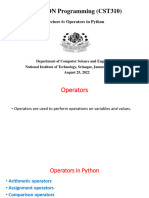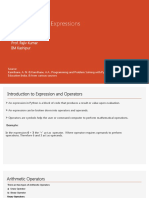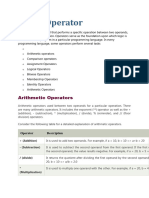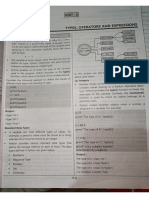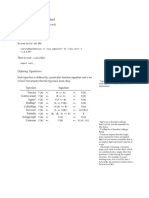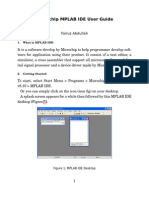Mathematical and logical operators in Python
Computer Programming 1
Program: Intermediate Diploma in Programming and Computer Science
Course Code: APPC121
Amira Alotaibi
College: Applied College
Institution: University Of Jeddah
Outline
❑ Introduction to Operators in Python
❑ Using Arithmetic Operators
❑ Unary Operator & Binary Operator
❑ Arithmetic Expressions
❑ How to Evaluate an Expression
❑ Augmented Assignment Operators
Introduction to Operators in Python
What are Operators?
Operators are symbols or keywords that allow Python programs to perform computations,
comparisons, and decision-making.
Why are Operators Important?
• They manipulate data efficiently.
• They perform calculations and control program logic.
• They compare values and manage program flow.
Using Arithmetic Operators
Arithmetic Operators in Python
• Operators: +, -, *, /, //, %, **
Operator Examples:
Unary Operator & Binary Operator
• The +, - and * operators are straightforward, but note that the + and - operators can be both unary
and binary
• A unary operator has only one operand a binary operator has two
• For example, the operator in +5 is a unary operator to negate the number 5 whereas the - operator
in 4 - 5 is a binary operator for subtracting 5 from 4
Float and Integer Division ( / & // ) Operator
The (/ )operator performs a float division that results in a floating number . For example:
The //operator performs an integer division; the result is an integer, and any fractional part is
truncated. For example:
Exponentiation ( ** ) Operator
To compute 𝒂𝒃 (a with an exponent of b) for any numbers a and b, you can write a** b in Python. For
example:
Remainder (%) Operator
The operator (%), known as remainder or modulo operator , yields the remainder after
division.
The left side operand is the dividend and the right side operand is the divisor .
Therefore, 7 % 3 yields 1, 3 % 7 yields 3,12 % 4 yields 0, 26 % 8 yields 2, and 20 % 13 yields 7.
Remainder (%) Operator
• Remainder is very useful in programming.
• For example, an even number % 2 is always 0
• An odd number % 2 is always 1
• So you can use this property to determine whether a number is even or odd.
• You can also mod by other values to achieve valuable results.
Check Point #6
What are the results of the following expressions?
Expression Result
Arithmetic Expressions
• Python expressions are written the same way as normal arithmetic expressions
• Example
can be translated into a Python expression as:
(3 + 4 * x) / 5 – 10 * (y - 5) * (a + b + c) / x + 9 * (4 / x + (9 + x) / y)
How to Evaluate an Expression
You can safely apply the arithmetic rule for evaluating a Python expression
1.Operators inside parenthesis are evaluated first
• Parenthesis can be nested
• Expression in inner parenthesis is evaluated first
2.Use operator precedence rule
• Exponentiation (**) is applied first
• Multiplication(*) float division(/) integer division(//) and remainder operators(%) are applied
next
▪ If an expression contains several multiplication, division, and remainder operators they
are applied from left to right
• Addition (+) and subtraction(-) operators are applied last
▪ If an expression contains several addition and subtraction operators they are applied
from left to right
Example
Here is an example of how an expression is evaluated:
Augmented Assignment Operators
• Very often the current value of a variable is used, modified, and then reassigned back to
the same variable
For example, the following statement increases the variable count by 1:
count = count + 1
• Python allows you to combine assignment and addition operators using an augmented (or
compound) assignment operator
• For example:
count += 1
Augmented Assignment Operators
Caution
There are no spaces in the augmented assignment operators.
For example, + = should be +=.
Augmented Assignment Operators
Using +=, -=, *=
• Example:
Boolean Types, Values, and Expressions
❑ Boolean Data Types
❑ Relational Operators
❑ Boolean Variables
❑ Convert Boolean Value to Integer
❑ Convert Numeric Value to Boolean
Boolean Data Types
Often in a program you need to compare two values, such as whether x is
greater than y.
▪ Or if an inputted value, such as radius, is less than zero.
Comparison Operators
Caution
The equal to comparison operator is two equal signs (==), not a single equal sign (=).
The latter symbol is for assignment.
Boolean variable
• A variable that holds a Boolean value is known as a Boolean variable.
• A Boolean variable can hold one of the two values: True or False.
• For example:
lightsOn = True
convert Boolean to int
Boolean variable
▪ convert Boolean to int
You can use the int function to convert a Boolean value to an integer. For example:
Output
▪ bool function
You can also use the bool function to convert a numeric value to a Boolean value. For example:
Output
Logical Operators
❑ Truth Table for Operator not
❑ Truth Table for Operator and
❑ Truth Table for Operator or
❑ Program 6: Test Boolean Operators
Logical Operators
Logical operators, also known as Boolean operators, operate on Boolean values to create a new
Boolean value.
Truth Table for Operator (not)
Truth Table for Operator (and)
Truth Table for Operator (or)
Operator Precedence and Associativity
▪ Order in which Python evaluates operators:
1- The expression in the parentheses is evaluated first
2- The operators are applied according to the precedence rule and the associativity
rule.
▪ The precedence rule





























